The Singer Tradition sewing machine manual provides comprehensive guidance for optimal use‚ ensuring versatility and reliability for various sewing tasks. It caters to both beginners and experienced sewists‚ offering detailed instructions on setup‚ operation‚ and maintenance to maximize productivity and creativity.
Overview of the Singer Tradition Sewing Machine
The Singer Tradition sewing machine is a versatile and reliable mechanical device designed for a wide range of sewing tasks. It features 32 built-in stitch types‚ including straight‚ zigzag‚ and decorative options‚ along with an automatic one-step buttonhole function. The machine is known for its durability and ease of use‚ making it suitable for both beginners and experienced sewists. Its compact design and lightweight construction allow for easy portability‚ while the free-arm sewing option provides flexibility for sewing cuffs‚ sleeves‚ and other hard-to-reach areas. The Singer Tradition is equipped with a rotary control dial for selecting stitches and adjusting settings‚ ensuring precise control over your sewing projects. With its robust features and user-friendly interface‚ this machine is ideal for crafting‚ quilting‚ and everyday sewing needs.
Importance of the Manual for Optimal Usage
The Singer Tradition sewing machine manual is essential for unlocking the machine’s full potential and ensuring safe‚ efficient‚ and effective operation. It provides detailed instructions for threading‚ setting up‚ and maintaining the machine‚ as well as troubleshooting common issues. The manual also explains how to use advanced features like the automatic one-step buttonhole and various stitch settings. By following the guidelines‚ users can prevent damage to the machine and achieve professional-quality results. Additionally‚ the manual serves as a valuable resource for understanding the machine’s components and accessories‚ making it indispensable for both beginners and experienced sewists. Regularly referring to the manual ensures optimal performance and extends the machine’s lifespan.
Target Audience for the Manual
The Singer Tradition sewing machine manual is designed for a wide range of users‚ including beginners‚ hobbyists‚ and experienced sewists. It is particularly useful for those who are new to sewing‚ as it provides clear‚ step-by-step instructions for setting up and operating the machine. Home sewers and crafters will also benefit from the detailed guidance on maintaining the machine and troubleshooting common issues. Additionally‚ the manual is a valuable resource for sewing educators and students‚ offering insights into advanced features and techniques. Whether you’re working on simple repairs or complex projects‚ the manual ensures that all users can maximize the machine’s capabilities and achieve professional-quality results.
Key Features of the Singer Tradition Sewing Machine
The Singer Tradition sewing machine is equipped with 32 built-in stitch types‚ offering versatility for various sewing projects. It features an automatic one-step buttonhole function‚ simplifying the creation of precise buttonholes. The machine includes a free-arm sewing option‚ ideal for sewing cuffs‚ sleeves‚ and other hard-to-reach areas. With adjustable stitch length and width‚ users can customize their stitches to suit different fabrics and techniques. The rotary control type ensures smooth operation‚ while the LED light provides excellent visibility for detailed work. Additional features include a range of presser feet for specialized tasks and a sturdy design that supports both heavy-duty and delicate sewing. These features make the Singer Tradition a reliable and adaptable machine for sewists of all skill levels.
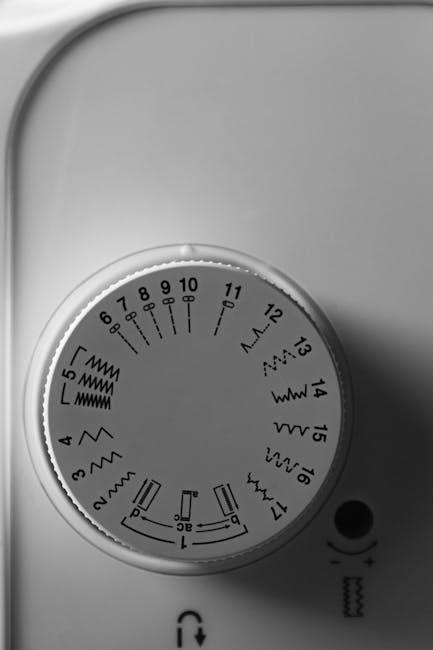
Understanding the Machine Components
The Singer Tradition sewing machine features a stitch selection dial‚ tension disc‚ and presser foot‚ essential for controlling stitch types‚ thread tension‚ and fabric handling. These components ensure precise sewing operations and customization‚ making the machine user-friendly and efficient for various projects.
Main Parts of the Singer Tradition Sewing Machine
The Singer Tradition sewing machine features essential components designed for efficient sewing. The stitch selection dial allows users to choose from various stitch types‚ while the tension disc ensures proper thread tension. The presser foot helps guide fabric smoothly‚ and the free-arm option enables sewing in tight spaces. The bobbin compartment holds the bobbin securely‚ and the needle plate provides a stable surface for sewing. Additional parts include spool pins for thread management and a handwheel for manual control. These components work together to make the machine versatile and reliable for various sewing tasks‚ ensuring precision and ease of use for both beginners and experienced sewists.
Accessories Included with the Machine
The Singer Tradition sewing machine comes with a variety of essential accessories to enhance your sewing experience. These include multiple presser feet‚ such as the zigzag foot‚ zipper foot‚ and buttonhole foot‚ each designed for specific tasks. Additional accessories feature a set of bobbins‚ a needle pack‚ and a seam ripper for easy corrections. A thread spool cap and spool pin are also provided for convenient thread management. Furthermore‚ a soft dust cover protects the machine when not in use‚ and an instructional DVD offers step-by-step guides for mastering various techniques. These accessories ensure versatility and ease of use‚ catering to both basic and advanced sewing projects‚ and help maintain the machine’s performance over time.
Understanding the Stitch Selection Dial
The Singer Tradition sewing machine features a user-friendly stitch selection dial that allows you to choose from a variety of stitch options with ease. This dial provides access to 32 built-in stitch types‚ including straight stitches‚ zigzag stitches‚ and decorative patterns. By rotating the dial‚ you can quickly select the desired stitch for your project. The machine also includes an automatic one-step buttonhole feature‚ which simplifies the process of creating perfect buttonholes. The dial’s intuitive design ensures that you can switch between stitches seamlessly‚ making it ideal for both basic and advanced sewing tasks. Refer to the manual for detailed guidance on using the stitch selection dial to achieve the best results for your specific sewing needs. This feature enhances creativity and efficiency‚ catering to a wide range of sewing projects.
Role of the Tension Disc in Sewing
The tension disc plays a crucial role in maintaining proper thread tension‚ ensuring smooth fabric feeding and consistent stitch quality. It gently grips the thread‚ applying the right pressure for even stitch formation. Adjusting the tension discs according to fabric type is essential—looser for delicate fabrics and tighter for heavier ones. Proper threading is vital; the thread must seat correctly between the discs to avoid uneven tension. Over-tightening can cause thread breakage or machine issues. Regular cleaning of the discs prevents lint buildup‚ ensuring optimal performance. The manual provides guidance on adjustment‚ maintenance‚ and troubleshooting‚ helping users achieve professional-looking stitches across various projects.
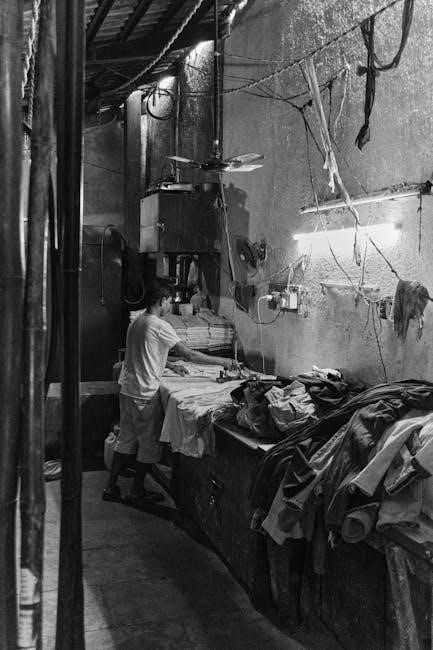
Threading and Setting Up the Machine
Threading and setting up the Singer Tradition sewing machine involves carefully following the manual’s step-by-step guide to ensure proper thread flow and tension for optimal stitching performance always.
Step-by-Step Guide to Threading the Top Thread
Threading the top thread on the Singer Tradition sewing machine requires careful attention to ensure smooth operation. Start by raising the take-up lever to its highest position and pulling the thread gently through the machine’s tension discs. Follow the diagram in the manual to guide the thread through the correct channels‚ ensuring it passes through the tension spring and the thread take-up lever. Once threaded‚ pull the thread to test the tension. Proper threading is essential for consistent stitching and to prevent thread breakage. Always refer to the manual or included diagrams for precise guidance‚ and avoid using damaged or frayed threads for optimal results.
Proper Way to Wind and Insert the Bobbin
To wind the bobbin‚ cut a piece of thread and insert it into the bobbin winder‚ ensuring it aligns with the machine’s guide. Hold the thread taut and wind it evenly‚ avoiding twists. Once full‚ trim the excess and remove the bobbin. To insert‚ lift the needle plate and locate the bobbin case. Place the bobbin inside‚ ensuring the thread flows smoothly through the tension spring. Pull gently to seat it properly. Always use Singer-branded bobbins for compatibility and optimal performance. Proper bobbin installation ensures even stitching and prevents thread breakage. Refer to the manual for diagrams to guide this process accurately.
Adjusting Thread Tension for Different Fabrics
Adjusting thread tension is crucial for achieving balanced stitches on various fabrics. Locate the tension discs on your Singer Tradition sewing machine and gently turn the dials to tighten or loosen the thread. For lightweight fabrics like cotton or silk‚ a lower tension setting is ideal‚ while heavier fabrics such as denim or canvas may require higher tension. Always test the tension on a scrap piece of fabric before starting your project. If the thread is too tight‚ stitches may pucker; if too loose‚ they may unravel. Refer to the manual for specific guidelines‚ and ensure proper thread alignment to maintain even tension. This step ensures professional-grade results for every fabric type.
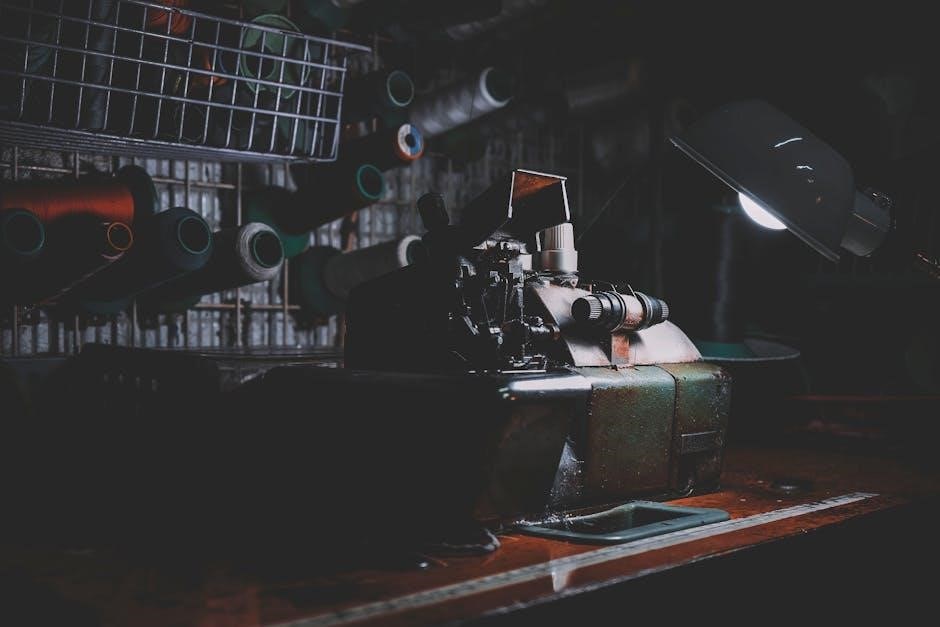
Basic Sewing Operations
The Singer Tradition sewing machine offers straightforward operations for straight stitching‚ zigzag stitching‚ and automatic one-step buttonholes‚ making it easy to handle various sewing tasks with precision and creativity.
Starting Your First Sewing Project
Starting your first sewing project with the Singer Tradition sewing machine is an exciting step. Begin by ensuring the machine is properly threaded and the bobbin is correctly inserted. Choose a simple fabric like cotton to practice. Align the fabric under the presser foot‚ ensuring it is straight. Select the straight stitch option for a basic seam. Gently guide the fabric as it moves under the needle‚ maintaining steady speed. Practice on scrap fabric before working on your actual project to build confidence. Always keep fingers away from moving parts and refer to the manual for troubleshooting if needed. This will ensure a smooth and enjoyable sewing experience.
Straight Stitch and Zigzag Stitch Functions
The Singer Tradition sewing machine features a straight stitch for basic sewing and a zigzag stitch for elastic fabrics or decorative edges. To select the straight stitch‚ use the stitch selection dial and choose the appropriate setting. For the zigzag stitch‚ rotate the dial to the zigzag option and adjust the stitch width as needed. The straight stitch is ideal for seaming and repairing‚ while the zigzag stitch prevents fraying on stretchy materials. Always test stitches on scrap fabric to ensure proper tension and alignment. These functions are essential for versatility in your sewing projects‚ making the Singer Tradition suitable for both beginners and experienced sewists.
Using the Automatic One-Step Buttonhole Feature
The Singer Tradition sewing machine offers an automatic one-step buttonhole feature‚ simplifying the process of creating professional-looking buttonholes. To use this feature‚ mark the desired buttonhole location on your fabric. Select the buttonhole stitch using the stitch selection dial. Place the fabric under the needle‚ aligning the mark with the presser foot. The machine will automatically sew a precise buttonhole in one step‚ including the sides and the bartack. This feature ensures consistent results‚ saving time and effort. It’s ideal for clothing and home decor projects‚ providing a polished finish. Always test the buttonhole on scrap fabric first to ensure proper settings for your specific fabric type.

Advanced Features and Techniques
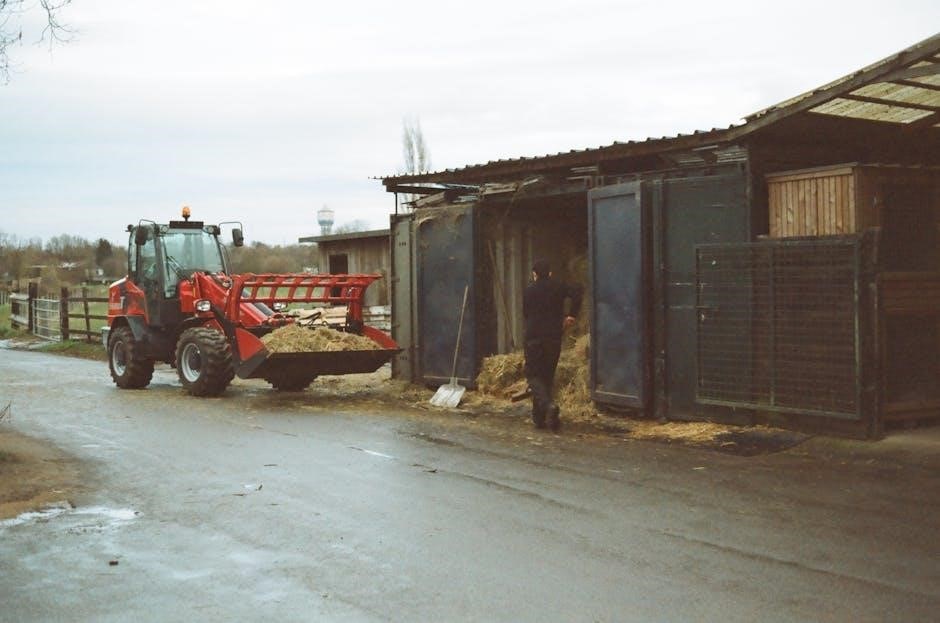
The Singer Tradition sewing machine offers advanced features like 32 built-in stitches‚ adjustable stitch length and width‚ and a free-arm option‚ enhancing creativity and precision for sewists.
Utilizing the 32 Built-In Stitch Types
The Singer Tradition sewing machine features 32 built-in stitch types‚ offering versatility for various sewing projects. These include straight stitches‚ zigzag stitches‚ decorative stitches‚ and stretch stitches‚ each designed for specific fabrics and tasks. Users can easily select stitches using the intuitive stitch selection dial. The machine also includes an automatic one-step buttonhole feature‚ perfect for creating consistent buttonholes. Decorative stitches add aesthetic value to projects‚ while stretch stitches are ideal for knit fabrics. By leveraging these stitch options‚ sewists can achieve professional results‚ whether sewing garments‚ home decor‚ or crafts. The manual provides clear guidance on selecting the right stitch for any material or technique‚ ensuring optimal performance and creativity.
Adjusting Stitch Length and Width
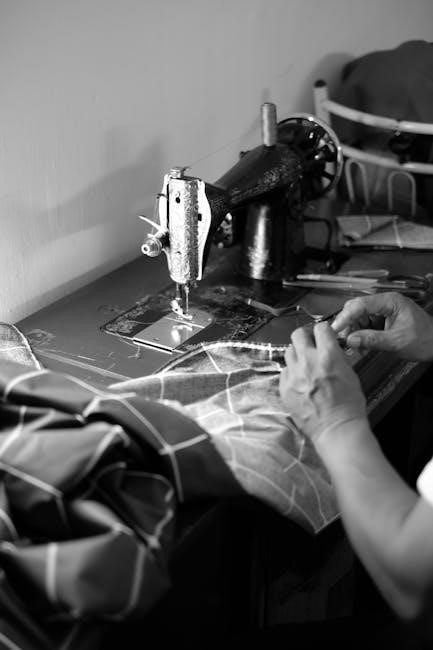
Adjusting the stitch length and width on the Singer Tradition sewing machine allows for precise control over your sewing projects. The machine features easy-to-use dials that enable you to modify these settings based on the fabric type and desired outcome. For delicate fabrics‚ shorter stitch lengths and narrower widths are recommended‚ while thicker materials may require longer stitches and wider widths. The manual provides clear instructions on how to adjust these settings‚ ensuring optimal results for various sewing tasks. Proper adjustment enhances stitch quality‚ prevents fabric damage‚ and ensures professional-looking seams. Always test the settings on scrap fabric before starting your project for the best results.
Using the Free-Arm Sewing Option
The Singer Tradition sewing machine offers a free-arm sewing option‚ ideal for sewing cylindrical or hard-to-reach areas like sleeves‚ pant hems‚ and children’s clothing. To activate this feature‚ simply remove the flatbed attachment‚ revealing the free arm. This allows for greater maneuverability and control when working on smaller or rounded fabrics. The free-arm option is particularly useful for delicate or intricate projects‚ ensuring precise stitching and even fabric flow. Always refer to the manual for specific instructions on how to attach or detach the flatbed and utilize the free-arm function effectively. This feature enhances your sewing experience‚ making it easier to handle a variety of creative and practical projects with ease and precision.
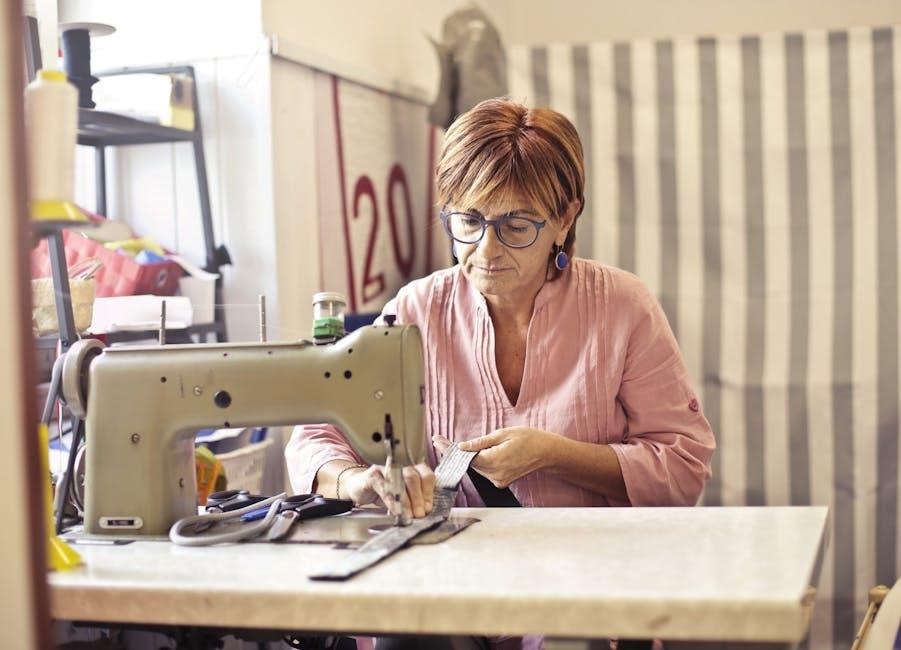
Maintenance and Care
Regular cleaning‚ oiling‚ and replacing parts ensures optimal performance. Always unplug the machine before cleaning and use genuine Singer needles for best results. Keep it covered when not in use to prevent dust buildup.
Cleaning the Machine After Use
Regular cleaning is essential to maintain the performance of your Singer Tradition sewing machine. Always unplug the machine before cleaning to ensure safety. Use a soft‚ dry brush to remove lint and debris from the exterior‚ bobbin area‚ and stitch plate. Avoid using harsh chemicals or abrasive cleaners‚ as they may damage the finish. Gently wipe down the machine with a damp cloth‚ focusing on visible surfaces. For internal cleaning‚ refer to the manual for specific guidance to avoid damaging mechanical parts. Cleanliness prevents dust buildup and ensures smooth operation. Regular maintenance helps extend the machine’s lifespan and keeps it running efficiently. Proper care ensures optimal stitching and overall functionality. Clean after every use for best results.
Oiling the Machine for Smooth Operation
Regular oiling is crucial for maintaining the Singer Tradition sewing machine’s smooth operation. Always use Singer-branded oil to ensure compatibility and performance. Turn off the machine and unplug it before oiling. Apply a few drops to the oiling points as indicated in the manual‚ using the provided dropper for precision. Avoid over-oiling‚ as it can attract lint and dust. Gently turn the handwheel to distribute the oil evenly across moving parts. Regular lubrication prevents friction‚ ensures consistent stitch quality‚ and extends the machine’s lifespan. Proper maintenance routines‚ including oiling‚ are essential for optimal functionality and longevity. Follow the manual’s guidelines for the best results and to keep your machine running effortlessly. Regular care ensures uninterrupted sewing sessions and professional-grade outputs.
Replacing the Needle and Other Parts
Replacing the needle and other parts on your Singer Tradition sewing machine is essential for maintaining optimal performance. Always use genuine Singer needles to ensure compatibility and prevent damage; To replace the needle‚ turn off and unplug the machine‚ then carefully remove the old needle using the screwdriver provided. Insert the new needle‚ ensuring it’s fully seated and aligned properly. Other parts‚ like the bobbin case or presser foot‚ may also need replacement over time. Refer to the manual for specific instructions on identifying worn parts and replacing them. Regularly inspecting and replacing these components will ensure smooth operation‚ prevent thread breakage‚ and maintain consistent stitch quality. Proper replacement procedures help extend the machine’s lifespan and keep it functioning at its best.
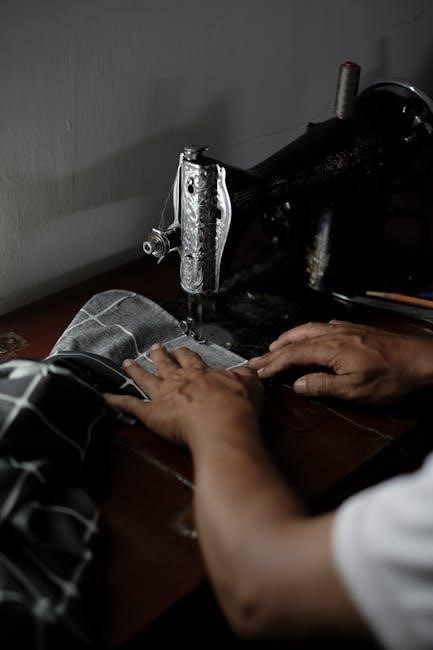
Troubleshooting Common Issues
Identify and resolve common problems like thread breakage‚ fabric feeding issues‚ or the machine not turning on. Consult the manual for step-by-step solutions to ensure smooth operation.
Machine Not Turning On
If your Singer Tradition sewing machine fails to turn on‚ ensure it is properly plugged into a functioning power outlet. Check the power cord for damage or tangles. Verify that the outlet is working by testing it with another appliance. If the issue persists‚ inspect the machine’s on/off switch for any visible damage or malfunctions. Consult the manual for guidance on resetting or troubleshooting electrical components. If the problem remains unresolved‚ contact Singer customer support or visit an authorized service center for professional assistance. Always unplug the machine before attempting any repairs to ensure safety. Regular maintenance‚ as outlined in the manual‚ can help prevent such issues and ensure smooth operation.
Fabric Not Feeding Properly
If the fabric is not feeding smoothly‚ ensure the presser foot is lowered and properly aligned with the fabric type. Check that the thread tension is balanced and not too tight‚ as this can cause resistance. Clean the machine’s feed dogs and surrounding areas to remove lint or debris that may obstruct movement. Verify that the feed dogs are in the “up” position and functioning correctly. If the issue persists‚ consult the manual for specific troubleshooting steps or adjust the machine’s feed system as recommended. Regular maintenance‚ such as oiling and cleaning‚ can help prevent feeding problems and ensure consistent performance. Always refer to the manual for detailed guidance on adjusting or servicing the feed mechanism.
Thread Breakage and Tension Problems
Thread breakage and tension issues are common challenges that can disrupt sewing. To address this‚ ensure the needle is correctly inserted and aligned‚ as improper installation can cause thread stress. Use genuine Singer needles‚ as they are designed for optimal performance. Check the thread path for tangles or twists and rethread the machine if necessary. Adjust the tension dials according to the fabric type‚ as outlined in the manual. If the thread continues to break‚ inspect for lint or debris in the tension discs and clean them. Regularly oiling the machine and replacing worn-out parts can also prevent such issues. Always refer to the manual for specific tension settings and maintenance tips to ensure smooth sewing operations. Proper care and adjustment can significantly reduce thread breakage and tension problems.
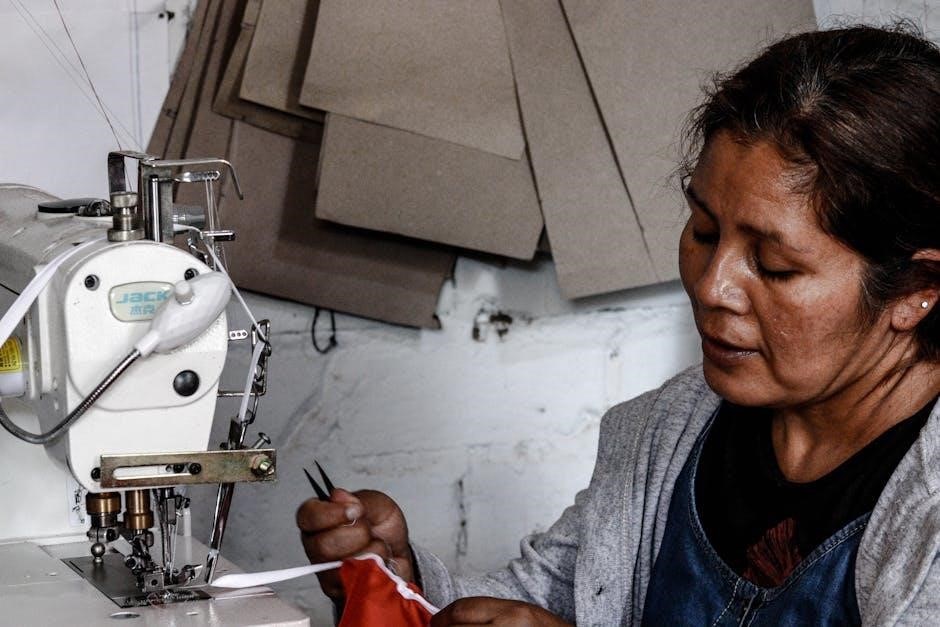
Tips for Getting the Most Out of Your Machine
Use genuine Singer needles and threads for optimal performance. Regularly clean and oil the machine to ensure smooth operation. Always use the correct presser foot for the job‚ and refer to the manual for stitch selection and tension adjustments.
Choosing the Right Needles and Threads
Using the correct needles and threads is essential for optimal performance of your Singer Tradition sewing machine. Always opt for genuine Singer needles‚ as they are designed to work seamlessly with your machine. Choose needle types based on fabric: sharp needles for woven fabrics‚ ballpoint for knits‚ and heavy-duty for thick materials. For threads‚ select high-quality options that match your fabric type to ensure strong‚ durable stitches. Regularly change needles after projects or if you notice wear. This prevents thread breakage and maintains stitch quality. Proper needle and thread selection enhances sewing efficiency and extends machine longevity‚ ensuring professional-grade results every time.
Using the Right Presser Foot for the Job
Using the appropriate presser foot for your sewing project is crucial for achieving professional results with the Singer Tradition sewing machine. The zigzag foot is ideal for general sewing and straight stitching‚ while the buttonhole foot simplifies creating perfect buttonholes. For delicate fabrics‚ the sheer foot provides gentle handling‚ and the zipper foot is designed for precise zipper installation. Always match the presser foot to your fabric type and stitching needs to ensure smooth fabric feeding and consistent stitch quality. Regularly cleaning and maintaining presser feet prevents dust buildup and ensures optimal performance. Refer to your Singer Tradition manual for specific foot recommendations tailored to your machine model‚ such as the Singer Tradition 2250 or 2273‚ to maximize efficiency and creativity in your sewing projects.
The Singer Tradition sewing machine manual serves as an essential guide to unlocking the full potential of your machine. By following the detailed instructions and tips provided‚ users can master various sewing techniques‚ from basic operations to advanced features. Whether you’re a beginner or an experienced sewist‚ this manual ensures you understand how to maintain‚ troubleshoot‚ and optimize your machine for countless projects. With its comprehensive coverage of features like stitch selection‚ presser feet‚ and maintenance routines‚ the manual empowers you to create with confidence and precision. Embrace your creativity and enjoy the reliability and versatility of the Singer Tradition sewing machine for years to come.
